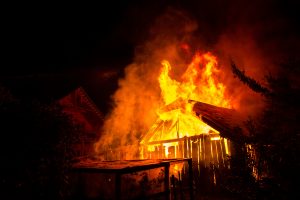 Nationwide, there are nearly 20 million properties that face "Moderate" risk of wildfire (up to a 6% chance of experiencing a wildfire over 30 years), according to new data from First Street Foundation’s Wildfire Model.
Nationwide, there are nearly 20 million properties that face "Moderate" risk of wildfire (up to a 6% chance of experiencing a wildfire over 30 years), according to new data from First Street Foundation’s Wildfire Model.
First Street Foundation’s 5th National Risk Assessment: Fueling the Flames is a report commissioned by First Street, a non-profit 501(c)(3) research and technology group working to define America's growing climate risk.
In addition to the 20 million properties in the line of "Moderate" risk of wildfire, the report found that six million properties face "Major" risk (up to 14% risk over 30 years); nearly three million face "Severe" risk (up to 26% over 30 years); and approximately 1.5 million face "Extreme" risk (greater than 26% risk over 30 years). More than 49 million properties face less than a 1% chance of experiencing a wildfire over a 30-year period, or "Minor" risk according to First Street Foundation’s methodology.
According to the National Oceanic and Atmospheric Administration (NOAA), the financial toll associated with wildfires has grown substantially, especially over the last half-decade, with $81.7 billion or 66% of all direct losses since 1980, occurring over the last five years.
First Street Foundation will make wildfire risk information available to users for free through its Risk Factor, where Fire Factor data will be presented alongside Flood Factor and other future perils, giving users a comprehensive understanding of their homes from physical climate risk today and 30 years into the future. Like Flood Factor, Fire Factor data will be integrated into Realtor.com, providing visitors to the site a property-level wildfire risk assessment in the form of a risk ranking from one (Minimal) to 10 (Extreme) for each property on the site.
"The lack of a property specific, climate adjusted wildfire risk for individual properties has severely hindered everyone from the federal government to your average American," said Matthew Eby, Founder and Executive Director of First Street Foundation. "As a changing climate drives more frequent and severe wildfire events, Fire Factor will prove critical in ensuring everyone has the insights they need to understand their personal risk to avoid and protect against the devastating impact of a wildfire."
A group of top climate and data scientists, technologists, and modelers from the Spatial Informatics Group, Reax Engineering, and Eagle Rock Analytics—members of the Pyregrence Consortium, as well as the USGS, and architectural design & engineering consulting group Arup—created an open source, freely available wildfire model that accounts for current and future climate conditions.
"According to a recent Realtor.com survey, seven out of 10 recent homebuyers considered the risk of natural disasters when deciding where to live. Realtor.com is adding Fire Factor to maps and properties to help home shoppers and homeowners make informed decisions," said Sara Brinton, Lead Product Manager for Realtor.com. "Wildfire risk information empowers consumers to protect their homes against the increasing threat of wildfire damage."

 DSNews The homepage of the servicing industry
DSNews The homepage of the servicing industry









